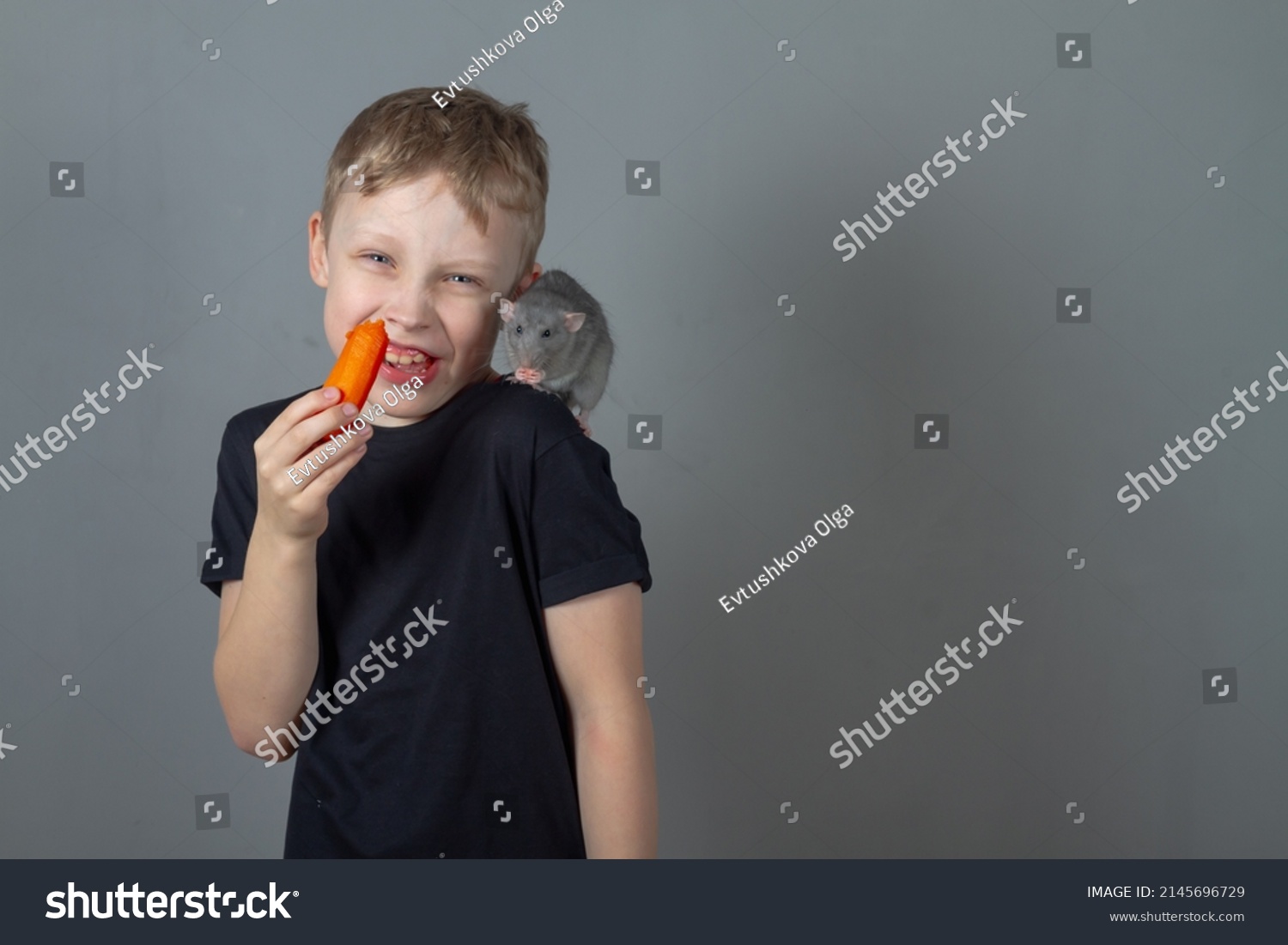Delving into the fascinating world of pet rats, one might encounter the intriguing term "blond rat." While not always a strictly defined color in official registries, this captivating description often refers to a spectrum of light-colored, often cream, fawn, or amber-hued rodents that charm enthusiasts with their unique appearance and often gentle dispositions.
This article aims to explore what constitutes a "blond rat" within the diverse realm of fancy rats, examining their genetic underpinnings, various coat patterns, and the delightful traits that make them beloved companions. We will draw upon established knowledge from sources like the American Fancy Rat and Mouse Association (AFRMA) and scientific insights to provide a comprehensive understanding, ensuring that you receive expert, authoritative, and trustworthy information on these remarkable creatures.
Table of Contents
- What Exactly is a "Blond Rat"? Defining the Hue
- The Genetic Canvas: Understanding Rat Coat Colors
- Patterns and Markings: The Blond Rat's Diverse Appearance
- Temperament and Personality: The Gentle Blond Rat
- Beyond Color: Coat Types and Body Styles
- Caring for Your Light-Colored Companion
- Official Standards vs. Everyday Terminology
- Dispelling Myths and Fictional Depictions
What Exactly is a "Blond Rat"? Defining the Hue
The term "blond rat" isn't a formal designation within the American Fancy Rat and Mouse Association (AFRMA) or other official rat clubs. Instead, it's a descriptive term often used by pet owners to describe rats with light, creamy, or yellowish fur. This can encompass several recognized color varieties that fall within the spectrum of what one might perceive as "blond."
For instance, "fawn" and "amber" are specific genetic colors that might be described as blond. As one enthusiast notes, "Both parents were agouti roof rats, we'd expect 25% amber babies." This highlights how specific genetic pairings can produce these lighter shades. The perception of color can also vary; "On the monitors here they look like agouti, cinnamon, black, and himi/light siamese," indicating that even within recognized colors, there's a range of visual interpretation. The crucial point is that "The color terms I use don't always match what AFRMA (or other clubs) recognize, mostly because what they recognize are limited to certain standards and don't always inform on the genotype of the animal." This means a rat described as "blond" might officially be a fawn, cream, or even a very light agouti, depending on its genetic makeup and specific shade.
Understanding the difference between an agouti color and a self-color is key to appreciating these nuances. "One way to tell the agoutis from the self colors are the bellies and feet," explains an experienced breeder. "Agouti colors will have pink bellies (will have a straight line between the top color and belly color) and light wrists, where self colors will have color on the belly and dark wrists (unless they have white markings on the legs)." This distinction helps classify the underlying genetic basis of a rat's coat, even if its outward appearance is simply described as a "blond rat."
The Genetic Canvas: Understanding Rat Coat Colors
The stunning array of colors and patterns seen in fancy rats, including those that might be called a "blond rat," are all products of complex genetic interactions. Rat coat color genetics involve multiple genes, each controlling different aspects of pigment production, distribution, and dilution. For instance, the agouti gene (A) determines whether a rat's hair shafts have bands of color (agouti) or are solid (non-agouti or "self"). This is fundamental to many light colors.
Dilution genes play a significant role in creating lighter shades. These genes reduce the intensity of pigment, transforming darker colors into lighter versions. For example, a black rat with certain dilution genes can become a blue, silver, or even a very light, almost "blond" cream. Similarly, an agouti rat with dilution genes can become a fawn or amber, which are classic examples of what might be colloquially termed a "blond rat." The scientific community continually researches these genetic underpinnings; for example, the study "Origins of albino and hooded rats, Implications from molecular genetic analysis across modern laboratory rat strains" by Takashi Kuramoto, et al., published in Plos One, August 2012, Volume 7, Issue 8, provides valuable insights into the molecular genetic analysis behind various rat strains and their traits, including coat color.
The interplay of these genes determines not just the base color but also how that color is expressed across the rat's body. Understanding these genetic principles helps breeders predict outcomes and appreciate the diversity of their litters. For instance, if "Both parents were agouti roof rats, we'd expect 25% amber babies," this prediction is based on the specific genetic alleles carried by the parents, leading to the expression of amber, a beautiful light, often "blond" hue.
Patterns and Markings: The Blond Rat's Diverse Appearance
Beyond the base color, "blond rats" can also come in a variety of fascinating patterns and markings, where the light color might be the primary body color, or part of a striking design. These patterns add to the visual appeal and individuality of each rat.
Hooded and its Variations
The hooded pattern is one of the most well-known and can certainly appear on a "blond rat" base. In its classic form, a hooded rat is described as "A rat with color over its head, neck, shoulders, and down the back in a stripe to the tail." The rest of the body is clean and white. This creates a striking contrast, especially if the colored areas are a light, blond-like shade.
There are several variations of the hooded pattern, all stemming from similar genetic mechanisms that restrict color to certain areas:
- Capped: "Like hooded rats but without the stripe down the back." Here, the color is confined to the head and neck area, making for a distinct "cap" of color on a white body. A "blond" cap on a white body would be particularly charming.
- Masked: "A white rat with a rectangle or oval of color over the eyes." This specific facial marking can appear on a predominantly white or light-bodied rat, giving it a unique look.
- Dalmatian/Roan (or similar spotting): "Again, like hooded rats except with spots down the back instead of a stripe." Instead of a solid stripe, these rats have distinct spots of color along their spine, resembling the pattern of a Dalmatian dog. If the spots are a light "blond" color, they stand out beautifully against a white background.
- Splashed/Variegated: "Once again, like hooded rats but with spotting over most of the body." This variation features more extensive and irregular patches of color distributed across the body, offering a more artistic and less defined pattern than the hooded or spotted types.
All these patterns demonstrate how a "blond" coloration can be expressed not just as a solid hue, but as part of intricate designs that highlight the rat's unique genetics.
Eye-Catching Facial Markings
Beyond the hooded variations, some rats display specific facial markings that can contribute to their overall "blond" aesthetic, especially if the markings themselves are a light color, or if they contrast with a lighter body. The "masked" pattern, as mentioned, is a prime example: "A white rat with a rectangle or oval of color over the eyes." While the description doesn't specify the color of the mask, if it's a light fawn or cream, it would certainly contribute to the perception of a "blond rat" with distinctive features.
Temperament and Personality: The Gentle Blond Rat
Beyond their captivating appearance, rats, including those with "blond" coloration, are renowned for their intelligence, social nature, and often affectionate personalities. While coat color doesn't directly dictate temperament, anecdotal evidence and breeder observations suggest interesting correlations. For instance, it's been noted that "fawn colored roof rats tend to be calmer and friendlier than their normal colored littermates." This observation, though not a universal scientific rule, suggests that certain genetic lines that produce lighter colors might also carry traits for a more docile disposition.
This sentiment is echoed by individual experiences, such as the proud owner stating, "Blondie's great grandchildren are beautiful, friendly and calm." This personal testimony reinforces the idea that specific lineages of light-colored rats can indeed exhibit exceptionally desirable temperaments. These rats are known to be highly intelligent, capable of learning tricks, responding to their names, and even being litter trained. They thrive on interaction with their human companions and often enjoy cuddling, playing, and exploring. Their social needs are significant; rats are happiest when housed in pairs or groups, as they are naturally communal animals.
The gentle and calm nature often associated with a "blond rat" makes them ideal pets for individuals and families alike. Their inquisitive minds and affectionate gestures can provide endless entertainment and companionship, forming strong bonds with their owners. This combination of striking looks and endearing personality is a major reason why light-colored rats are so sought after in the pet community.
Beyond Color: Coat Types and Body Styles
The diversity of fancy rats extends far beyond just color and markings; it also encompasses various coat types and body styles, which can further enhance the appeal of a "blond rat." These physical characteristics are determined by distinct genetic traits and add another layer of uniqueness to each individual rat.
One of the most popular coat type distinctions is between standard and Rex rats. "Les rats standards arborent un pelage court et lisse, tandis que les rats rex se distinguent par un pelage frisé et tout doux." Standard rats have a short, smooth, and sleek coat, which is the most common type. In contrast, Rex rats boast a unique curly coat that feels wonderfully soft and dense to the touch. This curliness extends to their whiskers, which are also crinkled. A "blond dumbo rex pet rat" would combine a light, creamy color with a luxuriously soft, curly coat and distinctive large, low-set Dumbo ears, creating a truly charming and unique appearance. The texture and density of the fur can vary even within these types, as "La densité du poil et la douceur va varier d'un rat à l'autre," meaning each rat's coat has its own subtle characteristics.
Beyond coat texture, body styles like "Dumbo" ears are another key feature. Dumbo rats have large, round ears set low on the sides of their heads, giving them a distinctive, almost puppy-like expression, contrasting with the higher-set ears of standard rats. A "Siamese dumbo rex pet rat" mentioned in the data, while not "blond," illustrates how these different traits combine to create specific varieties. Imagine a "blond rat" with Dumbo ears and a Rex coat – a truly adorable combination!
These variations in coat and body type mean that even if you're looking for a "blond rat," you have a wide array of choices in terms of their overall physical presentation, allowing you to find a companion that perfectly matches your aesthetic preferences.
Caring for Your Light-Colored Companion
Caring for a "blond rat" is essentially the same as caring for any other fancy rat, regardless of color. These intelligent and social creatures require specific care to thrive and live a happy, healthy life. "Pet rats are smaller than wild ones and can live up to three years," a lifespan that, while relatively short, is filled with companionship if they receive proper care.
Key aspects of rat care include:
- Housing: Rats need a spacious cage with good ventilation, multiple levels, and plenty of enrichment, such as hammocks, tubes, toys, and chew items. The cage should be cleaned regularly to maintain hygiene.
- Diet: A balanced diet is crucial. This typically consists of a high-quality commercial rat block as the staple, supplemented with fresh fruits, vegetables, and occasional protein sources. Avoid sugary or fatty human foods.
- Socialization: Rats are highly social animals and should never be kept alone. They thrive in pairs or small groups, providing each other with companionship, grooming, and play. Daily interaction with their human owners is also vital for their well-being and to strengthen the bond.
- Health Monitoring: Regular health checks and prompt veterinary care are essential. Rats are prone to certain health issues, such as respiratory infections and tumors, so being observant of any changes in their behavior or physical condition is important.
- Mental Stimulation: Their intelligence means they need mental stimulation. This can be provided through puzzle toys, training sessions, and supervised free-roam time outside the cage in a safe environment.
The popularity of rats as pets has grown significantly. "Rats have only become popular pets in the last century, even though they have lived with humans for thousands of years." This growing recognition is a testament to their endearing qualities and the joy they bring to their owners. Providing proper care ensures your "blond rat" lives a full and enriching life, demonstrating the responsibility and commitment required for these wonderful companions.
Official Standards vs. Everyday Terminology
When discussing rat varieties, it's important to understand the distinction between the informal terms used by pet owners and the official standards set by organizations like the American Fancy Rat and Mouse Association (AFRMA). As noted earlier, "The color terms I use don't always match what AFRMA (or other clubs) recognize, mostly because what they recognize are limited to certain standards and don't always inform on the genotype of the animal." This perfectly encapsulates why "blond rat" isn't an official term.
AFRMA, a leading authority in the fancy rat world, provides detailed descriptions and classifications for all recognized rat varieties. "The following is a brief description of the rat varieties as recognized by the American Fancy Rat and Mouse Association." This information is often "taken from the AFRMA brochure." For those interested in showing rats or understanding the precise genetic standards, it's crucial to consult their comprehensive guides: "For complete details of the standards including points, faults, eliminations, and disqualifications, please refer to the AFRMA show regulations & standards book."
These official standards are meticulously crafted to ensure consistency and fairness in judging at rat shows, defining specific colors (like Fawn, Amber, Cream), markings (Hooded, Capped, Masked), and physical characteristics (Dumbo, Rex). While a rat might be informally called a "blond rat" by its owner due to its light coloration, an AFRMA standard might classify it as an "Amber Hooded," a "Fawn Self," or a "Cream Dumbo Rex," based on its precise genetic makeup and physical attributes. This distinction doesn't diminish the beauty or appeal of a "blond rat," but it provides a framework for breeders and enthusiasts who adhere to formal recognition.
Dispelling Myths and Fictional Depictions
The term "blond" can sometimes lead to confusion, especially when encountering it in less conventional contexts. For example, the phrase "Blond beaver rat they are not related to beavers, but to rats" highlights a common misunderstanding. Despite the name, a "blond beaver rat" is still fundamentally a rat, not a hybrid or a rodent related to beavers. This simply refers to a rat with a specific light, often brownish-yellow or "blond" coloration, perhaps reminiscent of a beaver's fur, but genetically and biologically, it remains a domestic rat.
Furthermore, popular culture sometimes features "blond" animal characters that are entirely fictional, which can color public perception. For instance, "The blonde henchrat is a minor antagonist in Flushed Away." This character, part of a animated film, is depicted as "one of the Toad's henchrats" and is involved in cartoonish chases, even getting "electrocuted when he landed on water." While entertaining, such portrayals are purely imaginative and bear no resemblance to the characteristics or behaviors of real pet rats. It's important to distinguish between these fictional depictions and the actual qualities of a living, breathing "blond rat," which is a gentle, intelligent, and affectionate companion animal, far removed from any villainous roles or exaggerated physical traits seen on screen.
Conclusion
The journey into understanding the "blond rat" reveals a fascinating world of genetic diversity, intricate patterns, and endearing personalities. While "blond" may not be an official term in fancy rat standards, it beautifully encapsulates a spectrum of light-colored rats, from fawns and ambers to creams, often adorned with charming markings like hoods or masks. These rats, whether a "blond dumbo rex pet rat" or a simpler "blond" marked variety, are celebrated for their gentle temperaments and intelligence, making them truly exceptional companions.
As we've explored, the world of pet rats is rich with variety, extending beyond mere color to include diverse coat types and body styles. Caring for these intelligent creatures requires dedication, but the rewards of their companionship are immense. By understanding their needs and appreciating their unique characteristics, we can provide them with the best possible life. If you've been charmed by the allure of a light-colored rat, we encourage you to delve deeper into the world of fancy rats. Share your experiences with "blond rats" in the comments below, or explore other articles on our site to learn more about these incredible animals!


